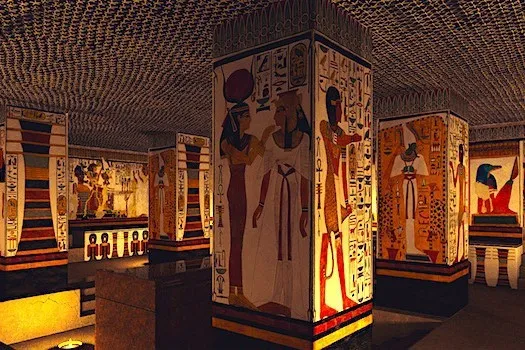Recent News

1
Jan
Valley Of The Queens
Valley of the Queens:
The Valley of the Queens consists of the main wadi, where most of the tombs are located, as well as the Valley of Prince Ahmose, the Valley of the Rope, the Valley of the Three Pits, and the Valley of the Dolmen. The main wadi contains 91 tombs, with an additional 19 tombs in the side valleys. The burials in the side valleys all date back to the 18th Dynasty.
The reason for choosing the Valley of the Queens as a burial site is unknown. It might have been due to its proximity to the workers' village of Deir el-Medina and the Valley of the Kings. Another consideration could have been the presence of a sacred grotto dedicated to Hathor at the valley's entrance, which may have been associated with the rejuvenation of the dead.
Together with the Valley of the Kings and nearby Thebes, the Valley of the Queens was added to the UNESCO World Heritage List in 1979.
Geology:
The Valley of the Queens lies on a geological formation of limestone, marl, clay, chalk, and shale. The clay in the valley has expanded and contracted due to recurrent flash floods, leading to unstable tomb constructions and later damages. Rockfalls caused by shrinking clay deposits and tectonic events have not only damaged the tombs but also the wall paintings within them.
The current landscape of the Valley of the Queens was shaped by faults and subsequent subsidence during the Pliocene and Pleistocene eras, tilting the original horizontal stratigraphy. This tilt exposed deposits of minerals like anhydrite, gypsum, and halite. Salt from halite in the soil has damaged tomb paintings. Seeping groundwater has entered the tombs, causing dissolved and recrystallized salts.
Gypsum, along with clay, was commonly used as plaster in ancient Egypt. However, due to limited data, the exact composition of ancient plasters is hard to determine. This is debated because variations in color, hardness, and the amount of gypsum used can be observed within a single tomb.
18th Dynasty:
One of the first tombs built in the Valley of the Queens is the tomb of Princess Ahmose, a daughter of Seqenenre Tao and Queen Sitdjehuti, likely dating back to the reign of Thutmose I. Tombs from this period also include several nobles, such as a stablemaster and a vizier.
The tombs in the Valley of the Three Pits mostly date to the Thutmosid period. They are labeled A–L, and three shaft tombs in this valley give it its name. These modern-designated tombs are QV 89, QV 90, and QV 91.
In the Valley of the Dolmen, an ancient path used by workers to travel from Deir el-Medina to the Valley of the Queens passes by a small rock-cut temple dedicated to Ptah and Meretseger.
Tombs from this time generally have simple designs, consisting of a chamber and a burial shaft. Some tombs were expanded to accommodate multiple burials, including royal princes, princesses, and nobles.
A tomb for princesses existed in the valley during the reign of Amenhotep III. Its location is currently unknown, but artifacts from the tomb, including fragments of burial equipment, have been found in museums. Items include a canopic jar fragment of Queen Henut, believed to have lived during the mid-18th Dynasty. Her name was enclosed in a cartouche. Canopic jar fragments mentioning Prince Menkheperre, a son of Thutmose III and Merytre-Hatshepsut, have also been found. Another royal consort, Nebetnehat, from the mid-18th Dynasty, is attested through canopic jar fragments. Additionally, fragments of a canopic jar with the name of Princess Ti from the mid-18th Dynasty were discovered.
19th Dynasty:
During the 19th Dynasty, the use of the valley became more selective. Tombs from this period exclusively belonged to royal women. Many high-ranking wives of Ramses I, Seti I, and Ramses II were buried in the valley. One of the most famous examples is the rock-cut tomb of Queen Nefertari (1290–1224 BCE). The polychrome reliefs in her tomb remain intact. Other members of the royal family continued to be buried in the Valley of the Kings, such as KV5, the tomb of Ramses II's sons.
The tomb of Queen Satre (QV 38) was likely the first built during this dynasty, probably begun under Ramses I and completed during Seti I’s reign. Several tombs were prepared without a designated owner, with names inscribed only after the royal woman's death.
20th Dynasty:
In the early 20th Dynasty, the valley was still heavily used. Tombs were prepared for the wives of Ramses III, and, deviating from the previous dynasty's conventions, several tombs for royal sons were also built. Tomb construction lasted at least until the reign of Ramses VI. The Turin Papyrus mentions the creation of six tombs during Ramses VI's reign, though it is unclear which tombs these were.
Evidence suggests economic unrest during the 20th Dynasty. Records show workers went on strike during Ramses III’s reign, and tomb robberies were reported toward the dynasty's end.
Third Intermediate Period and Later:
After the 20th Dynasty, the valley ceased to serve as a royal burial site. Many tombs were extensively reused, modified to accommodate multiple burials, and in some cases, burial pits were dug into existing tombs. Little is known about the valley's use during the Ptolemaic period, but it was heavily used again during the Roman era as a burial site. During the Coptic period, hermit dwellings were established, and tombs such as QV60 (Nebettawy) and QV73 (Henuttawy) show evidence of Coptic occupation. Wall scenes were plastered over and adorned with Christian symbols. The Christian presence lasted until the 7th century CE.



_1_lg.webp)
_lg.webp)
_lg.webp)
_lg.webp)

_lg.webp)
